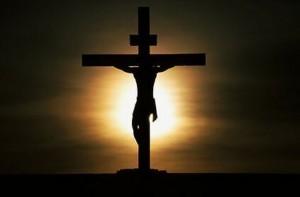
Holy Cross

The Holy Cross is one of the most popular signs of Christianity and depicts the cross on which Jesus Christ died. During the first two centuries of Christianity, the cross may have been rare in Christian iconography, as it depicts a purposely painful and gruesome method of public execution and Christians were reluctant to use it. A symbol similar to the cross, the staurogram, was used to abbreviate the Greek word for cross in very early New Testament manuscripts such as P66, P45 and P75, almost like a nomen sacrum (nomina sacra).[7] The extensive adoption of the cross as Christian iconographic symbol arose from the 4th century.
The earliest depiction of the Christian Cross may be the Herculaneum Cross which was found in the city of Herculaneum, which was entombed in pyroclastic material along with Pompeii during the eruption of Mount Vesuvius in AD 79. Another early depictions of the cross as a Christian symbol may be as early as 200 AD when it was used to mock the faith in the Alexamenos graffito.
The cross symbol was already associated with Christians in the 2nd century, as is indicated in the anti-Christian arguments cited in the Octavius of Minucius Felix, chapters IX and XXIX, written at the end of that century or the beginning of the next, and by the fact that by the early 3rd century the cross had become so closely associated with Christ that Clement of Alexandria, who died between 211 and 216, could without fear of ambiguity use the phrase τὸ κυριακὸν σημεῖον (the Lord’s sign) to mean the cross, when he repeated the idea, current as early as the apocryphal Epistle of Barnabas, that the number 318 (in Greek numerals, ΤΙΗ) in Genesis 14:14 was interpreted as a foreshadowing (a “type”) of the cross (T, an upright with crossbar, standing for 300) and of Jesus (ΙΗ, the first two letter of his name ΙΗΣΟΥΣ, standing for 18),[11] and his contemporary Tertullian could designate the body of Christian believers as crucis religiosi, i.e. “devotees of the Cross”.[12] In his book De Corona, written in 204, Tertullian tells how it was already a tradition for Christians to trace repeatedly on their foreheads the sign of the cross.[13] The crucifix, a cross upon which an image of Christ is present, is not known to have been used until the 6th century AD.
The Jewish Encyclopedia says:
The cross as a Christian symbol or “seal” came into use at least as early as the second century (see “Apost. Const.” iii. 17; Epistle of Barnabas, xi.-xii.; Justin, “Apologia,” i. 55-60; “Dial. cum Tryph.” 85-97); and the marking of a cross upon the forehead and the chest was regarded as a talisman against the powers of demons (Tertullian, “De Corona,” iii.; Cyprian, “Testimonies,” xi. 21–22; Lactantius, “Divinæ Institutiones,” iv. 27, and elsewhere). Accordingly the Christian Fathers had to defend themselves, as early as the second century, against the charge of being worshipers of the cross, as may be learned from Tertullian, “Apologia,” xii., xvii., and Minucius Felix, “Octavius,” xxix. Christians used to swear by the power of the cross
In contemporary Christianity, the cross is a symbol of the atonement and reminds Christians of God’s love in sacrificing his own son for humanity. It represents Jesus’ victory over sin and death, since it is believed that through his death and resurrection he conquered death itself. See Colossians 2:15, “Having disarmed the powers and authorities, he made a public spectacle of them, triumphing over them by the cross”.
Roman Catholics, Eastern Orthodox, Oriental Orthodox, members of the major branches of Lutheranism, some Anglicans, and other Christians often make the Sign of the Cross upon themselves. This was already a common Christian practice in the time of Tertullian.
The Feast of the Cross is an important Christian feast. One of the twelve Great Feasts in Eastern Orthodoxy is the Exaltation of the Cross on September 14, which commemorates the consecration of the basilica on the site where the original cross of Jesus was reportedly discovered in 326 by Helena of Constantinople, mother of Constantine the Great. The Catholic Church celebrates the feast on the same day and under the same name (In Exaltatione Sanctae Crucis), though in English it has been called the feast of the Triumph of the Cross.
Roman Catholic, Eastern Orthodox and Anglican bishops place a cross [+] before their name when signing a document. The dagger symbol (†) placed after the name of a dead person (often with the date of death) is sometimes taken to be a Christian cross